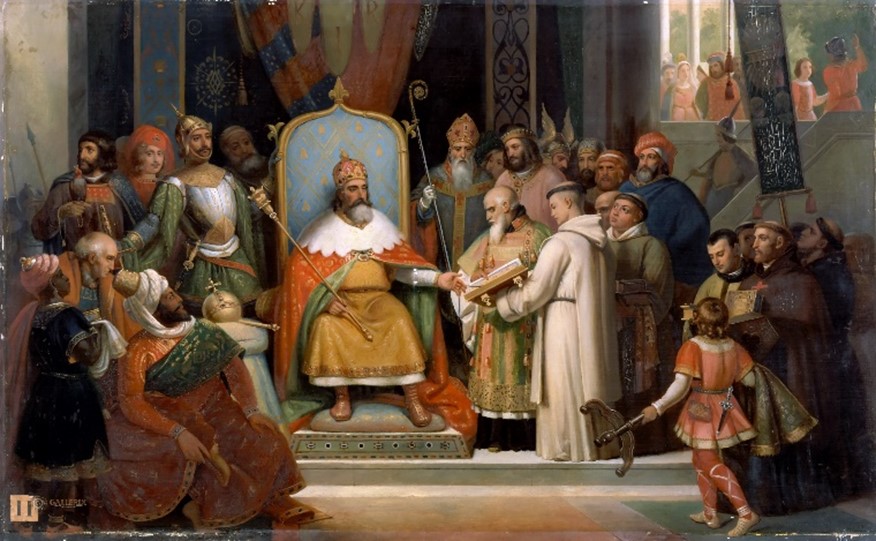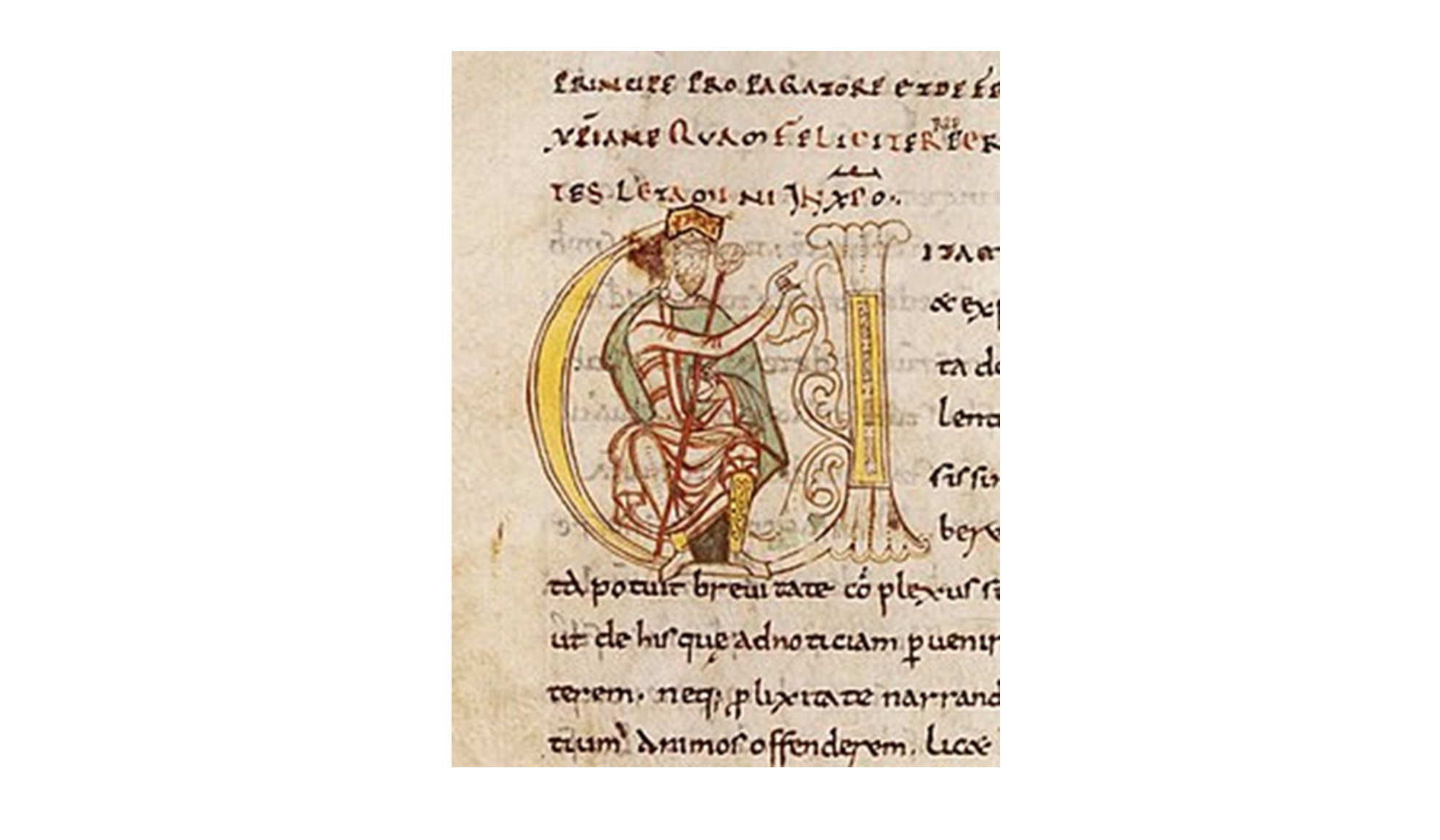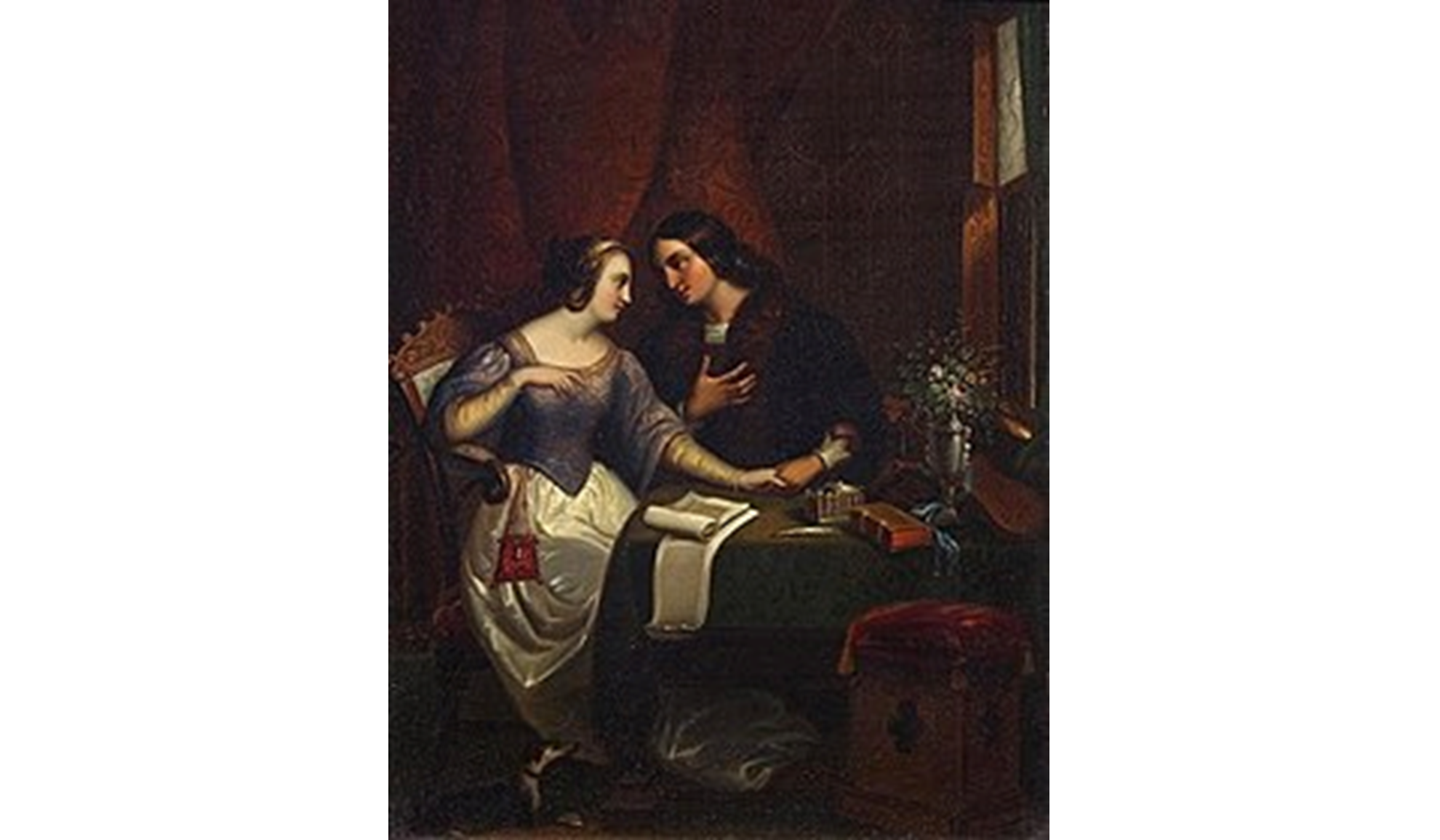Marion Gibbs looks at the medieval use of the Roman orator
Until relatively recently, it was generally held that after the fall of the Roman Empire Western Europe descended into the “Dark Ages”. The works of pagan Classical writers were thought to have been almost unknown to medieval Christian scholars until their rediscovery by Petrarch at the dawn of the “Renaissance” in the 14th century. However, just as archaeology is now revealing to us the sophistication of many European peoples who were previously dismissed as Dark Age barbarians, so Classical texts were not quite as lost or unread as was once imagined.
The picture is muddied by the loss of so many medieval manuscripts and library catalogues—some in Henry VIII’s destruction of the monasteries—and by the widespread use of florilegia (collections of quotations) and the writings of St Augustine (354-430 AD). Augustine was steeped in a number of Cicero’s works. People of his generation were taught rhetoric through Cicero’s Hortensius (now lost) and some of his own texts were either written as a direct response to those of Cicero or contained numerous quotations from them. As he was a Christian saint he was naturally studied by medieval scholars.
Parchment was scarce and precious and so books were never discarded or destroyed, but kept merely to be recycled: and yet the evidence shows that these texts were being cited, copied, requested and exchanged—all pointing to a lively interest in the supposedly ‘dead’ author. Christian scholars in medieval Western Europe were clearly interested in the writings of ‘Tulli’, as they often called him. Indeed, his rhetorical works, On Invention (a handbook for young orators, a youthful, unpolished tract which Cicero himself later regretted having published) and On the Orator formed the basis of the standard Latin education in monasteries and cathedrals.
Some medieval writers claimed that they were studying Cicero because of his excellent Latin style or as models for their own letter-writing. Others borrowed copiously from his philosophical works without always acknowledging this. His sentiments were sometimes airbrushed into something resembling Christianity, rather than acknowledging that he was pagan: so for instance passages could be quoted with seeming accuracy, but with ‘God’ inserted to replace Cicero’s references to ‘gods’ or more abstract concepts. Some scholars, however, openly went to great lengths to acquire, compare and correct as many manuscripts of Cicero’s texts as possible.
In spite of limited means of travel, these scholars journeyed widely throughout Western Europe. Those with reputations for erudition were head-hunted by rulers and by others in powerful positions. For example, Alcuin was a scholar at York, before being summoned to Charlemagne’s court at Aix-La-Chapelle (at that time Aachen in Germany) in 782 to preside over the palace school. His writings show a good knowledge not just of Cicero’s rhetorical works, but of his speeches concerning Milo, Verres and King Deiotarus. Alcuin had also studied the Tusculan Disputations. In mourning for Tullia, his beloved daughter, Cicero had devoted himself to Greek philosophy and in this tome he considers: the contempt of death, bearing pain, grief, emotional disturbances and whether virtue alone is sufficient for a happy life. Numerous medieval scholars studied it, somehow reconciling it with their Christian beliefs.
Charlemagne receiving manuscripts from his tutor, the monk Alcuin (Jules Laure (1806-1861))
Alcuin became abbot of St Martin at Tours in 796 where he founded a scriptorium (a place where manuscripts were copied by monks), which became a valuable repository of manuscripts. A late 8th century library catalogue from Charlemagne’s court includes nine of Cicero’s individual speeches—speeches found also in an early 9th century manuscript from Tours which is now in the British Library and was almost certainly copied from the one in Charlemagne’s library. Another 9th century manuscript from Tours contains ten different speeches, as well as the usual On Invention and two of Cicero’s late philosophical works which made a great impact on a number of medieval scholars: On Friendship and On Old Age. Surely these would not be collected and copied unless they were being read?
One of Alcuin’s students at the palace school was a layman, Einhard, whose writings show that he, too, knew theTusculan Disputations well. He corresponded with Lupus of Ferrieres who explained that he was eager to study Cicero and reproduce his gravitas “just as other distinguished men of Christian faith had”. Lupus not only collected, but compared and corrected manuscripts of various works of Cicero. Though he had one copy of On Invention, and had consulted another at Fulda, he wrote to Einhard asking to borrow his for comparison. Similarly, he requested On the Orator not only from Einhard, but also from Pope Benedict III. Lupus also wrote to Walafrid, the librarian at Reichenau, asking for a copy of Cicero’s Against Verres. Meanwhile, he was working on correct versions of some of the Letters to his Friends (Ad Familiares), and of the Aratea, Cicero’s translation of a poem, Phaenomena, by the Greek writer Aratus. He also had clear and detailed knowledge of On Old Age.
Einhard as scribe: manuscript from 1050
Some chose to make collections of suitable quotations for others to use. Sedulius Scotus, an Irish monk, compiled a Collectaneum at Charlemagne’s court at Liège in the mid-9th century. This includes extracts from Cicero’s Paradoxes, On Invention, Tusculan Disputations, and numerous speeches. Hadoard, a librarian at the monastery of Corbie, included many excerpts from Cicero in a florilegium – drawing on his Academics, On the Nature of the Gods, On Divination, On Fate, On the Laws, Paradoxes, Timaeus, On Duties, On the Orator, Tusculan Disputations, On Friendship and On Old Age. Hadoard openly acknowledged that he loved to read and re-read the works of Cicero, not just for their style, but for their content. He expressed a genuine desire to share what he had discovered as a librarian with others who did not have such access. Clearly, these monks would not have diligently produced such collections unless other scholars used them, apparently to gain kudos from displaying their knowledge of Cicero’s books.
The 10th and 11th centuries were particularly turbulent in Western Europe, yet scholars still managed to travel and to study, although some were imprisoned or forced into exile. Ratherius’s writings, for example, show familiarity not only with the ubiquitous On Invention, but also with On Friendship and some of Cicero’s speeches. Gunzo of Novara states that he brought copies of 100 texts, including some of Cicero, to the court of Otto. Heriger of Lobbes demonstrated an extensive, accurate knowledge of the Tusculan Disputations. However, Gerbert of Aurillac was the most remarkable. He travelled widely, spending time in Spain, then at the court of Otto before becoming master of the cathedral school at Rheims and finally abbot of Bobbio. Bobbio already had a large library, but Gerbert endeavoured to add more manuscripts. He corresponded with numerous scholars, including Gisilbert and Constantine, asking for copies of Cicero’s manuscripts, sometimes to compare with versions he already had. He asked Ayrard, a fellow monk at Aurillac, to make copies for him. A manuscript still survives of On the Orator with the inscription “his Ayrard wrote this to please Gerbert, the venerable philosophante abbot”. Writing to Romulf, abbot of Sens, Gerbert requested somewhat poetically “streams of Cicero for a thirsty man” – a remarkable appeal from a Christian abbot.
At the monastery of St Gall, Notker II translated Boethius’ commentaries on Cicero’s Topics into German and wrote his own treatise on rhetoric containing many quotations from Cicero. His letter to the Bishop of Sion reveals that Abbot Bern of Reichenau had borrowed the First Philippic from St Gall and the commentary on Topics, depositing a manuscript of On Inventione and another commentary as security. From another letter, it is apparent that Abbot Bern also owned a copy of On Friendship. Anselm of Besate, a scholar from Milan, made his living as a peripatetic teacher of grammar and rhetoric. He owned a copy of the Philippics, which he explains he had sought out and bought to study. Anselm accuses Rotiland of having stolen this book from Ado, as the text contained marginal glosses by Ado. The world of borrowing and buying books was obviously not straightforward in the Middle Ages.
Evidence of interest in Classical learning in the 12th century is much more abundant. A catalogue of the library at Cluny records many of Cicero’s texts, some in multiple copies, not just a large number of speeches and the usual philosophical and rhetorical treatises, but also 16 Books of letters to Atticus and two copies of his Letters to his Friends. William, the librarian at Malmesbury, searched all over England, aiming to collect all of Cicero’s available works. He made a manuscript containing 22, including 12 authentic speeches. Philip Harcourt, an English educated cleric bequeathed a substantial 88 volumes to the abbey of Bec, where he died in 1163. Six of these included a total of 17 works by Cicero, several in more than one copy. The circulation of manuscripts is illustrated by a florilegium compiled at Orleans which includes numerous extracts from Cicero: those from his speeches are all taken from the 9th century Tours manuscript described earlier, which was then copied at Orleans in the 12th century.
A lively correspondence between Reinald of Dassel and Wibald of Corvey reveals that both men knew Cicero’s works and owned copies. Wibald explains that he was eager to make a collection of all the known works of Cicero in one volume because he admires his writing style and wit, although disapproves of his pagan doctrines. Wibald also quotes from and mentions Cicero in letters to other scholars. A manuscript now in Berlin containing 30 of Cicero’s complete or partial texts has been recognised as the one compiled by Wibald.
In his Teaching of the Philosophers on Moral Questions, William of Conches claims ancient philosophers had visited him in his sleep and inspired him (a device Cicero used in his Dream of Scipio), and that Cicero appeared first. This work contains some 165 references to On Duties, and others to On Invention, On Friendship and On Old Age. It was hugely popular for 300 years: 67 Latin and 38 Old French manuscripts survive. Thierry of Chartres, Marbod, Peter Abelard, Herbord of Michelsberg, John of Salisbury and Otto of Friesing also display their knowledge of Cicero in their writings.
Cicero’s On Friendship particularly appealed to those living in close all-male communities. A 12th century Bishop of Rennes, Marbod, wrote a moralising work in verse which included chapters entitled On Old Age and On True Friendship. The former bears little resemblance to Cicero’s treatise, but the latter includes striking echoes and paraphrases of On Friendship. Aelred of Rievaulx’s On Spiritual Friendship, is very similar in many ways to Cicero’s tract and includes verbatim passages. Indeed, in his prologue, Aelred openly states that reading On Friendship had inspired him in his own work.
The evidence for female medieval scholars is unfortunately scant. Mathilda, daughter of King Malcolm of Scotland and wife of Henry I of England, was educated at the convents of Wilton and Romsey and was renowned for her learning. In one of her extant letters she quotes a passage from Cicero’s On Old Age not found in other medieval writers or florilegia, and elsewhere she compliments Cicero on his epistolary style and gravitas. Similarly, Heloise, erstwhile lover of Abelard and later an Abbess, was clearly well educated and had studied Cicero’s rhetorical works and other texts, quoting On Invention in a letter to Abelard. Few of her many letters remain, though some of those ascribed to Abelard were probably actually written by her.
Jean-Baptiste Goyet, Héloïse et Abailard, c. 1829 (Wikipedia)
This brief survey shows us that monks, abbots and even a pope managed to reconcile collecting and studying Cicero’s works with their Christian faith. Were these anomalous or are they simply the surviving examples of something much more widespread? I would suggest the latter. Space has precluded me from including more examples, but I hope your curiosity may have been sparked.
Marion Gibbs (Baldock) is a lifelong Classicist, a teacher, OU lecturer, former HMI and educational columnist, who taught throughout her 21-year headship until retirement. She wrote her M.Litt thesis some years ago on Cicero in Early Medieval Scholarship and her book Greek Tragedy an Introduction was published in 1989.



